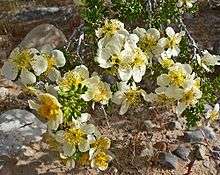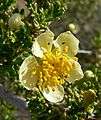Purshia
Purshia (bitterbrush or cliff-rose) is a small genus of 5-8 species of flowering plants in the family Rosaceae, native to western North America, where they grow in dry climates from southeast British Columbia in Canada south throughout the western United States to northern Mexico. The classification of Purshia within the Rosaceae has been unclear.[1][2] The genus was originally placed in the subfamily Rosoideae, but is now placed in subfamily Dryadoideae.[3]
| Purshia | |
|---|---|
 | |
| Purshia stansburyana | |
| Scientific classification | |
| Kingdom: | Plantae |
| Clade: | Tracheophytes |
| Clade: | Angiosperms |
| Clade: | Eudicots |
| Clade: | Rosids |
| Order: | Rosales |
| Family: | Rosaceae |
| Subfamily: | Dryadoideae |
| Genus: | Purshia DC. ex Poir. |
| Type species | |
| Purshia tridentata | |
| Species | |
|
See text | |
 | |
They are deciduous or evergreen shrubs, typically reaching 0.3–5 m tall. The leaves are small, 1–3 cm long, deeply three- to five-lobed, with revolute margins. The flowers are 1–2 cm diameter, with five white to pale yellow or pink petals and yellow stamens. The fruit is a cluster of dry, slender, leathery achenes 2–6 cm long. The roots have root nodules that host the nitrogen-fixing bacterium Frankia.[4]
The evergreen species were treated separately in the genus Cowania in the past; this genus is still accepted by some botanists.
Species
- Purshia ericifolia — Heath cliffrose. Texas.
- Purshia glandulosa — Desert bitterbrush. Nevada, Utah, Arizona.
- Purshia mexicana — Mexican cliffrose (syn. Cowania mexicana). Mexico, Arizona.
- Purshia pinkavae — Pinkava's cliffrose. Arizona.
- Purshia plicata — Antelope bush (syn. Cowania plicata). Mexico (Nuevo León).
- Purshia stansburyana — Stansbury cliffrose (syn. P. mexicana var. stansburiana, Cowania stansburiana). Idaho south to California, Arizona and New Mexico.
- Purshia subintegra (possibly a hybrid between P. pinkavae and P. stansburyana). Arizona.
- Purshia tridentata — Antelope bitterbrush. British Columbia south to California and New Mexico.
 P. tridentata, Lava Beds National Monument
P. tridentata, Lava Beds National Monument P. stansburiana, Red Rock Canyon, Nevada
P. stansburiana, Red Rock Canyon, Nevada P. stansburiana, Red Rock Canyon, Nevada
P. stansburiana, Red Rock Canyon, Nevada
References
- Morgan, D.R.; Soltis, D.E.; Robertson, K.R. (1994). "Systematic and evolutionary implications of rbcL sequence variation in Rosaceae". American Journal of Botany. 81 (7): 890–903. doi:10.1002/j.1537-2197.1994.tb15570.x. JSTOR 2445770.
- Eriksson, T.; Hibbs, M.S.; Yoder, A.D.; Delwiche, C.F.; Donoghue, M.J. (2003). "The phylogeny of Rosoideae (Rosaceae) based on sequences of the internal transcribed spacers (ITS) of nuclear ribosomal DNA and the trnL/F region of chloroplast DNA". International Journal of Plant Sciences. 164 (2): 197–211. doi:10.1086/346163.
- Potter, D.; Eriksson, T.; Evans, R.C.; Oh, S.; Smedmark, J.E.E.; Morgan, D.R.; Kerr, M.; Robertson, K.R.; Arsenault, M.; Dickinson, T.A.; Campbell, C.S. (2007). "Phylogeny and classification of Rosaceae". Plant Systematics and Evolution. 266 (1–2): 5–43. doi:10.1007/s00606-007-0539-9.
- Swensen, S.M.; Mullin, B.C. (1997). "The impact of molecular systematics on hypotheses for the evolution of root nodule symbioses and implications for expanding symbioses to new host plant genera". Plant and Soil. 194 (1–2): 185–192. doi:10.1023/A:1004240004063.
External links
- Jepson Flora Project: Purshia — (click 'taxon' to see treatments of California native species)
![]()
Purshia at Wikimedia Commons